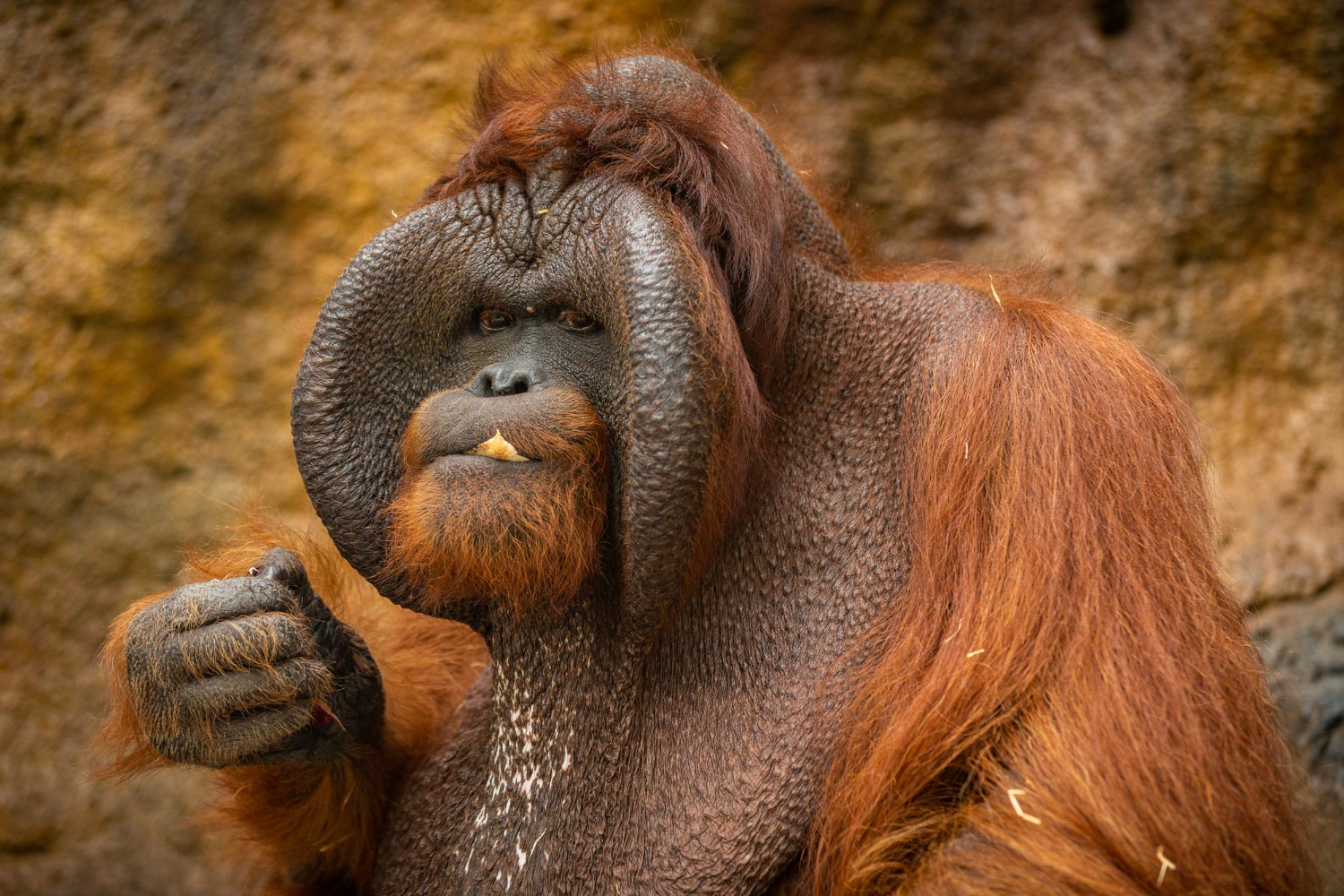The orangutan—often affectionately mispronounced as orangatang—is one of the most fascinating creatures in the natural world. Found only on the islands of Borneo and Sumatra, these great apes have long captured the curiosity of researchers, conservationists, and animal lovers alike. Their gentle eyes, thoughtful expressions, and quiet intelligence set them apart from all other primates. Orangutans move gracefully through the forest canopy, living lives of remarkable independence and wisdom.
As close relatives to humans, sharing about 97% of our DNA, orangutans give us an extraordinary window into our own evolution. Yet, their story is not just about genetics—it’s one of resilience, creativity, and the ongoing struggle for survival in a world that’s rapidly changing. Understanding orangutans helps us understand not only nature’s intricate design but also our place within it.
Understanding the Orangutan — Nature’s Gentle Thinker
The name orangutan comes from the Malay words “orang” (person) and “hutan” (forest), meaning “person of the forest.” It’s the perfect description for these intelligent, tree-loving apes. Orangutans are the largest arboreal mammals on Earth, spending nearly all their lives high above the ground.
There are three recognized species: the Bornean orangutan (Pongo pygmaeus), the Sumatran orangutan (Pongo abelii), and the Tapanuli orangutan (Pongo tapanuliensis), discovered only recently in Indonesia’s Batang Toru forests. Each species has subtle differences. For instance, Sumatran orangutans tend to have longer facial hair and lighter coloring, while Bornean orangutans are slightly stockier and darker.
What truly makes the orangutan exceptional is its unique blend of strength and serenity. Unlike their more social cousins like chimpanzees or gorillas, orangutans lead quiet, mostly solitary lives. Yet, behind their calm nature lies a mind of immense complexity—capable of problem-solving, emotional understanding, and even creativity.
Life in the Canopy — How Orangutans Thrive in Rainforests?
Imagine living your entire life among the treetops. For an orangutan, the forest canopy isn’t just home—it’s a complete world. Their long arms, powerful hands, and flexible joints allow them to move easily between branches, swinging gracefully in search of food.
The rainforest offers everything an orangutan needs: fruit, leaves, bark, termites, and sometimes honey or bird eggs. Fruit is their favorite meal—especially the durian, a spiky, strong-smelling delicacy found in Southeast Asia. Because fruit trees are scattered and seasonal, orangutans must travel long distances, sometimes remembering the location of certain trees for years, returning exactly when the fruit ripens.
Compared to other great apes, orangutans move slowly and deliberately. This unhurried pace is energy-efficient—a perfect strategy for surviving in an environment where food availability changes with the seasons. Every evening, they build a fresh nest out of branches and leaves, high in the trees, where they sleep safely away from predators.
Beyond their personal habits, orangutans play a vital ecological role. By eating fruit and spreading seeds through their droppings, they help sustain the forest’s incredible biodiversity. In a sense, the rainforest grows because orangutans live there.
The Social World of Orangutans
Orangutans are often described as solitary, yet their interactions reveal deep emotion and intelligence. Adult males typically live alone, establishing and defending territories marked by loud, long calls that can carry through miles of forest. These calls not only warn rivals but also attract females looking for mates.
Female orangutans share a very different lifestyle. They have strong, lifelong bonds with their offspring. A mother orangutan cares for one baby at a time for up to eight years—the longest childhood of any animal except humans. During these years, the youngster learns critical survival skills: how to find food, build nests, and navigate the canopy.
Communication among orangutans is subtle but expressive. They use gestures, facial expressions, and even vocal signals to share emotions or warnings. Researchers have observed behaviors resembling hugs, kisses, and comforting touches. Such gentle connections reveal a rich social and emotional world, one that mirrors many aspects of human relationships.
Signs of Remarkable Intelligence
Among all non-human primates, orangutans stand out as some of the most intelligent. In captivity and in the wild, these apes demonstrate tool use, memory, and foresight that rival our expectations of human-like thinking.
Wild orangutans have been observed using sticks to extract insects, leaves as umbrellas during rain, and even folded branches as makeshift cups for drinking water. This creativity is not learned through imitation alone; orangutans can invent and refine their own tools based on need and experimentation.
Their intelligence extends to long-term planning. For example, an orangutan may construct a shelter in the morning if it senses rain coming, or gather certain foods for the next day’s journey. Emotional intelligence is another hallmark—orangutans express empathy, patience, and curiosity, showing a deep awareness of their environment and the beings within it.
Because of these traits, researchers often refer to orangutans as “the thinkers of the forest.” Each behavior reflects not instinct alone, but careful decision-making and adaptability—qualities that continue to astonish scientists studying cognition and consciousness.
The Challenges Facing Orangutans Today
Despite their resilience, orangutans are critically endangered. Deforestation, driven by logging, palm oil plantations, mining, and human settlement, has destroyed much of their rainforest home. As forests shrink, orangutans are forced into smaller areas, leading to increased conflict with humans. Some are captured illegally for the pet trade, others injured or killed when searching for food in agricultural lands.
These challenges are not abstract—they are immediate and severe. In just a few decades, orangutan populations have dropped dramatically. The Bornean orangutan is now classified as endangered, while both the Sumatran and Tapanuli species are critically endangered. Each lost forest patch pushes them closer to extinction.
Climate change adds yet another layer of threat. Longer dry seasons and unpredictable fruiting cycles make it harder for orangutans to find consistent food sources. Their slow reproductive rate—females give birth only once every seven or eight years—means that population recovery is painfully slow, even under good conditions.
Global and Local Efforts to Protect Orangutans
Thankfully, hope remains. Around the world, conservation groups, scientists, and local communities are working to give orangutans a fighting chance. Sanctuaries and rehabilitation centers in Borneo and Sumatra rescue orphaned orangutans, teach them survival skills, and release them back into the wild.
Organizations are also pushing for sustainable palm oil production, encouraging companies to adopt policies that protect forest habitats and support responsible farming. Governments and NGOs are creating protected zones where orangutans can live and move freely without human interference.
Education and community involvement are key. Indigenous groups who live near orangutan habitats are being empowered to manage forests sustainably, combining traditional knowledge with modern conservation techniques. Each small success—each rescued orangutan, each newly protected forest—represents a step toward a more balanced future.
How Every Individual Can Make a Difference?
Protecting orangutans isn’t just the responsibility of environmental organizations—it’s something everyone can contribute to. Every choice we make as consumers and global citizens affects the forests where orangutans live. Choosing products made from sustainable palm oil, supporting eco-certified brands, and reducing unnecessary paper and plastic consumption all help reduce the pressure on rainforests.
Spreading awareness is also vital. Sharing reliable information, supporting wildlife charities, and teaching others about the importance of healthy ecosystems can create a ripple effect of positive change. Even simple actions, such as planting trees or reducing carbon emissions, indirectly support orangutan habitats by slowing global deforestation.
Each small effort counts. As the old saying goes, “If you think you’re too small to make a difference, try sleeping with a mosquito.” In the case of orangutans, millions of individual actions can collectively secure a brighter, greener future.
The Enduring Legacy of the Orangutan
Beyond their beauty and intelligence, orangutans remind us of something profound: humans and nature are inseparable. Watching an orangutan’s calm gaze or gentle movement offers a silent lesson in patience, balance, and respect for the natural world.
These forest thinkers show us that intelligence isn’t loud or dominant—it can be quiet, steady, and deeply connected to the rhythms of life. Their story reflects both the fragility of nature and its capacity for renewal when given the chance to recover.
Preserving orangutans means preserving the health of entire ecosystems. When the “person of the forest” thrives, so does the rainforest, and so do we. Their continued existence is both a gift and a responsibility—a reminder that wisdom and kindness often dwell in the least expected places.
Conclusion
The orangutan, or “orangatang” as some affectionately call it, stands as one of Earth’s most intelligent and gentle creatures. From their treetop homes in Borneo and Sumatra, these majestic beings show us a picture of both vulnerability and brilliance. They challenge us to think, to care, and to act.
In an era shaped by technology and fast change, the orangutan’s quiet life in the canopy offers timeless wisdom—about coexistence, stewardship, and the delicate bonds that hold all living things together. Through global conservation efforts and collective individual action, there is still hope that the orangutan’s story will continue for generations to come.
Their survival is more than an environmental goal—it’s a symbol of our shared capacity for empathy and intelligent care for the planet we call home.
My name is Mustafa, and I have been blogging for over 5 years. I am passionate about sharing complete, accurate, and helpful information with my readers. Along with managing content on The Matcha Read, I also contribute blog posts to premium websites. My goal is to provide valuable insights in a clear and easy-to-understand way, so every reader walks away with useful knowledge.










